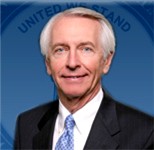
Investment in education, children means deep cuts to many agencies
FRANKFORT, Ky. – Saying Kentucky needs to lead, not cower, Governor Steve Beshear on Tuesday unveiled a two-year budget proposal that combines harsh cuts and strategic borrowing to create funding for historic proposals that support Kentucky’s schools and workforce.
Gov. Beshear’s proposed 2014-2016 biennial budget increases per-pupil K-12 funding to its highest level ever; restores damaging cuts to teacher training, textbooks, school safety and Extended School Services; expands preschool services to more than 5,100 more children; dedicates funds to expand high-speed broadband access throughout the state; uses “agency bonds” for the first time ever to invest in the campuses of Kentucky’s two-year community and technical colleges; restores funding to desperately needed child-care assistance programs that help parents stay employed; and builds a $24 million advanced manufacturing training center that will supply workers to the auto industry and other sectors.
In his budget address to legislators, Gov. Beshear urged legislators to join him in using the two-year budget to make a tangible and bold difference in the lives of Kentucky families.
“So tonight, we must answer a fundamental question: Does Kentucky march aggressively into the future, or do we cower under the covers as the world leaves us behind? Do we lead, or are we too afraid to even follow?” the Governor asked.
“This budget proposal clearly gives my answer: We can and we must build a more vibrant Kentucky. And this proposal provides the roadmap to do just that.”
In his State of the Commonwealth address two weeks ago, the Governor signaled his intentions to cut other areas of state government to fund education, although he said Tuesday that he was “painfully aware” of what those cuts would do.
The challenge, he said, was that moderate projected increases in revenue are not sufficient to cover the growth in required expenses and maintenance of current levels of services. As a result, Gov. Beshear recommended $98.6 million in cuts over the biennium. Many agencies will see reductions of five percent in the first fiscal year, then a straight-lined (no increase or decrease) budget for the second year. Since 2008, many of those agencies have seen their budgets slashed by 41 percent. These cuts could lead to delays in service, loss of federal funds, possible facility closures, and even possible layoffs.
“Imagine running a business and being told to maintain the same level of services while slashing your budget 41 percent. That is a difficult and sometimes impossible task,” said Gov. Beshear.
The Governor exhorted legislators to make these investments in education, even by slicing funding for other needs. The state’s school district budgets are stretched to their limits thanks to the simultaneous impacts of diminished property taxes and years of stagnant state budget allocations. Despite those challenges, the Governor said Kentucky schools and students have excelled – and it is critical to maintain that momentum.
“We are accelerating the momentum that has seen Kentucky leap ahead of many other states in measures of student performance and policy reform,” he said. “This budget proposal strategically focuses our very limited resources on what I believe will deliver the greatest return: a more highly educated population that will become a more talented workforce.”
Improving Kentucky’s Competitiveness through Strategic Investments
Improving Competitiveness through Education: The most important investments in the Governor’s proposed budget are in K-12 education. The largest item is SEEK, the main funding formula for our classrooms. From 2000 to 2008, SEEK grew an average of 3.4 percent each year. But from 2008 to 2014, funding flatlined – even as enrollment expanded, costs increased and local support in some areas declined. In effect, per-pupil spending dropped, even though the annual SEEK allocation remained the same.
Governor Beshear recommends investing $189 million over the biennium into SEEK, bringing per pupil spending to its highest total ever.
That allocation will include pay increases for all teachers and classified school personnel (2 percent the first year, 1 percent the second year).
Gov. Beshear’s proposed education investments also include:
•$100 million for school facilities construction to replace aging K-12 school buildings through General Fund-supported bonds
Improving Competiveness through Higher Education: The Governor also recommends using $520.3 million in General Fund supported bonds and $704 million in agency bonds to invest in critical infrastructure for our state universities. These investments include new construction, such as new science buildings, health care and student services facilities, as well as renovation and maintenance projects.
The budget also recommends $60 million for Bucks for Brains, the endowment match program which helps universities attract world class faculty for research and innovation.
For the first time, the Governor recommends authorizing $145.5 million in agency bonds for the Kentucky Community and Technical College System. About 100,000 students access education through KCTCS and its 16 colleges and 73 campuses. The General Fund can’t meet the system’s infrastructure needs, so KCTCS leadership recommended issuing agency bonds for up to 75 percent of project costs. The remaining 25 percent will come from local communities and other public or private sources. The bonds will support one project at each KCTCS college
Improving Competiveness through Economic Development: The Governor’s top priority throughout his administration has been helping Kentucky businesses thrive and attracting new jobs to the Commonwealth. His proposed budget recommends several investments to continue the state’s economic development momentum.
Improving Competiveness by Strengthening Eastern Kentucky: To support the continuing efforts of the “Shaping Our Appalachian Region”, or SOAR initiative, Gov. Beshear recommends multiple investments in the region to enhance economic development and leverage public-private partnerships.
Improving Competitiveness through Strengthening Families and Children: Gov. Beshear recommends investing in services that support families and children, to help families become economically stable and to ensure safety for our youngest citizens.
Competitiveness through Improving Health: The federal Affordable Care Act created $166.7 million in savings for the Commonwealth, which the Governor is reinvesting in health and family services such as Medicaid, child care assistance and numerous other services. Among those investments:
Investing in Pension Solvency and State Workforce: Gov. Beshear’s budget proposal fully funds the actuarially recommended contribution (ARC) for the Kentucky Retirement System. That means additional General Funds of $101.3 million in FY15 and $106.3 million in FY16.
The state’s workforce has not had a raise since 2010. Gov. Beshear recommends a sliding scale of salary increases for all state workers, with the largest percentage increase – 5 percent – going to workers earning $27,000 or less per year in FY15, and a 1 percent across-the-board raise in FY16.
Competitiveness through Transportation Infrastructure: The Governor’s Biennial Highway Construction Plan would provide about $1 billion in new construction each year for transportation improvements across the Commonwealth.
Proposed projects include widening and extending the Mountain Parkway for economic development in eastern Kentucky, completion of the six-laning of Interstate 65 and continuation of funding for the Ohio River Bridges Project.
The proposed plan also would provide for badly needed new bridges across Lake Barkley and Kentucky Lake, funding to support the Brent Spence Bridge project in northern Kentucky and continuation of long-awaited projects to complete the I-69 Corridor in western Kentucky.
New Investments Funded through Severe Cuts Elsewhere
Gov. Beshear noted that this budget does not rely on new funding from sources like gaming or tax modernization. Instead, the new investments are largely created through new, deep cuts of 5 percent for many state agencies. Some agencies are held to just 2.5 percent reductions, including higher education institutions and state police. A few agencies are protected entirely from cuts.
“Look, I am painfully aware that with this reduction, our colleges and universities will have undergone cumulative cuts of 17 percent during this historic recession. This was one of the most difficult choices made in this budget, because higher education deserves more support, not less,” lamented Gov. Beshear. “But there simply is no way to create enough money to make the needed investments in pre-K through 12th grade unless higher education is included in the reductions.
The Governor warned that with these new cuts, many agencies will have endured cumulative cuts of 41 percent since 2008. The impact of these cuts may include service delays, more employee attrition, possible layoffs, loss of federal funds, and possible facility closures.
“I am deeply disturbed by the damage these reductions will cause. Much of the “right-sizing” we’ve done with state government over the last seven years was needed,” he said. “But some cuts went way too deep.”
Governor Calls for Bipartisan Cooperation; Support for Gaming, Tax Reform
The Governor acknowledged that he could have simply slashed the budget across the board, but instead, he chose to make damaging cuts to some areas in order to make strategic investments in education. He pointed to tax reform and gaming as two alternatives that would allow much more progress and more investment with far less damage to needed services.
The Governor will present a tax modernization proposal to legislators soon, which will offer specific recommendations on how to move the Commonwealth’s antiquated tax system into the 21st century and make the state more competitive.
“One of the silver linings of a more competitive tax structure is that it will, as the economy grows, also stabilize long-term revenue – not because of higher rates, but because it's aligned with today's economy, instead of one that existed a century ago,” said Gov. Beshear.
Expanding gaming would produce additional recurring revenue even faster – again, not by creating a new burden on Kentuckians but by capturing a revenue stream that already exists.
“Kentuckians are currently spending hundreds of millions of entertainment dollars on gaming – but they’re spending it in other states, funding programs outside our borders,” said the Governor. “Let’s allow Kentuckians to decide this issue by placing a Constitutional Amendment on the ballot related to expanded gaming.”
He concluded his remarks by reminding the legislators of their recent successes attained by working across party lines – everything from robust prescription drug laws to pension reform.
“I believe that with the same level of respect, collaboration and vision, we can direct the resources of this budget to help Kentucky maintain its position as an innovative force in this 21st century world,” he said. “Now, let’s get to work.”
FACT SHEETS: Education; Families; Health Care; Jobs; SOAR









